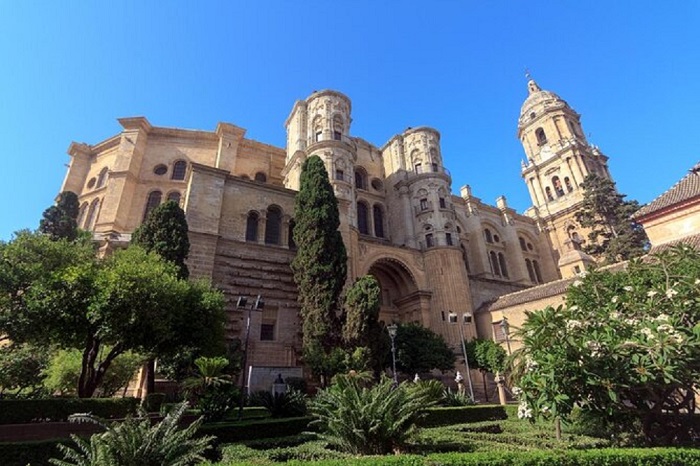
Maria Gomez,
“La Manquita never ceases to amaze me every time I see it”
A seasoned travel writer and a proud Malagueña. Born and raised in the heart of Málaga, Maria has spent years exploring the rich history, culture, and beauty of her hometown and Andalusia. Her passion for her city, combined with her knack for storytelling, makes her the perfect guide to take you on a virtual tour of the iconic landmarks of Málaga.
Welcome, dear readers, to another exciting journey through the rich history and cultural heritage of Málaga. Today, we are going to explore one of the city’s most iconic landmarks, affectionately known by locals as “La Manquita”. This term, translating to “The One-Armed Lady”, is a fond nickname given to the Cathedral of Málaga, a testament to the city’s vibrant past and a symbol of its enduring spirit. This grand edifice, with its single tower reaching for the heavens, is a sight to behold and a story to unravel. So, let’s embark on this journey together, delving into the history, architecture, and cultural significance of La Manquita, the heart of Málaga.
The History of La Manquita
The Origin of La Manquita
Our journey into the past begins in the year 1487, a pivotal moment in the history of Málaga. This was the year when the city was taken over by the Catholic Monarchs, Ferdinand and Isabella, marking the end of the Moorish rule that had lasted for more than seven centuries. The existing mosque, a symbol of the Islamic reign, was then converted into a Christian cathedral, marking the beginning of a new era. This was the birth of what we now know as La Manquita, a structure that would evolve over the centuries to become a symbol of Málaga’s rich cultural heritage.
The Conversion to a Cathedral
The transformation of the mosque into a cathedral was a significant undertaking. The initial design was entrusted to the renowned architect Enrique Egas, who was brought in from Toledo. His vision for the cathedral was grand, but it was not to be. The task of bringing the cathedral to life was eventually handed over to Diego de Siloé, a celebrated architect known for his work on other Andalusian cathedrals, such as the Cathedral of Granada and the Cathedral of Almería. Siloé’s vision for the cathedral was a blend of Gothic and Renaissance elements, a style that was becoming increasingly popular during this period.
The Gothic Attempt
The initial plan for the cathedral was to follow the Gothic architectural style, which was prevalent at the time. However, this plan was soon abandoned. The Gothic style, with its pointed arches and intricate details, was replaced by the more modern and innovative Renaissance style. This marked a significant shift in the architectural direction of the cathedral, setting the stage for the unique structure that we see today. The decision to abandon the Gothic style was not an easy one, but it was a necessary step to ensure that the cathedral would reflect the changing tastes and preferences of the period.
The Birth of the Renaissance Cathedral
Under the guidance of Diego de Siloé, the cathedral began to take shape. The architect brought with him the Renaissance style, characterized by its symmetry, proportion, and the incorporation of classical Greek and Roman elements. The cathedral was dedicated to the Virgin of the Incarnation and was designed to be a testament to the artistic and architectural brilliance of the era. The design included a large central nave flanked by two smaller ones, a transept, and a semicircular apse. The interior was adorned with intricate carvings and sculptures, reflecting the influence of the Renaissance style.
The Evolution of Construction in the Early Years
The construction of the cathedral was a long and arduous process, spanning several decades. A number of notable architects, including Andrés de Vandelvira, Hernán Ruiz I, and Diego de Vergara, were involved in the project. Each brought their unique touch to the design and construction of the cathedral, contributing to its distinctive aesthetic. Vandelvira, for example, was responsible for the design of the choir, while Ruiz and Vergara worked on the main façade and the towers.
The cathedral, still incomplete, was finally consecrated on August 3, 1588. The construction continued into the early 18th century, with funds being allocated to complete the project. However, the international situation of the Spanish Empire at the end of the century, particularly during the American War of Independence, left the cathedral without sufficient funds. This led to the halt of construction, leaving the cathedral with just one tower, and earning it the affectionate nickname “La Manquita”.
The history of La Manquita is a fascinating tale of architectural evolution, cultural transformation, and enduring resilience. Despite the challenges and changes it has undergone over the centuries, the cathedral stands today as a symbol of Málaga’s rich history and cultural heritage. It is a testament to the city’s past, a beacon in its present, and a promise for its future. As we delve deeper into the history of La Manquita, we discover not just the story of a building, but the story of a city and its people.
Your Spanish Journey Starts Here: Buenos Aires, Malaga, or Anywhere You Are
Are you ready to embark on a language adventure that’s as exciting as it is educational? Whether you’re yearning for the vibrant city life of Buenos Aires, the sun-drenched charm of Malaga, or the convenience of online learning, we’ve got just the ticket!

Learn Spanish Online
Can’t travel right now? No problem! Our online Spanish classes bring the language, culture, and fun right to your living room. Engage with our experienced teachers and enjoy interactive lessons from wherever you are in the world.
www.vamospanish.com/online-spanish-classes/

Learn Spanish in Malaga
Imagine yourself soaking up the Andalusian sun as you learn Spanish in Malaga. Our school offers a unique blend of top-notch education and laid-back beach vibes. It’s not just a language course – it’s your passport to the Mediterranean lifestyle!
www.vamospanish.com/spanish-school-malaga/

Learn Spanish in Buenos Aires
Dive into the heart of Argentina with our Spanish school in Buenos Aires. Experience the city’s pulsating energy, rich history, and captivating culture as you master the Spanish language. Buenos Aires is calling – will you answer?
www.vamospanish.com/spanish-school-buenos-aires/
The Unfinished Masterpiece
The Official Inauguration
Despite the cathedral’s incomplete state, it was officially inaugurated on August 3, 1588, in a grand ceremony that was the talk of the town. The city’s elite, dressed in their finest attire, gathered to witness the unveiling of what was to become one of Málaga’s most iconic landmarks. The cathedral, even in its unfinished state, was a sight to behold. Its grandeur and architectural brilliance were evident, and it was clear that it was destined to become a symbol of the city’s rich cultural heritage. The inauguration marked a significant milestone in the cathedral’s history, a moment of celebration and anticipation for what was yet to come.
The Choir
One of the most striking features of the cathedral is its choir. Designed by the renowned architect Andrés de Vandelvira, the choir is a masterpiece of Renaissance design. The intricately carved wooden stalls, the stunning altarpiece, and the magnificent organ all contribute to the choir’s breathtaking beauty. Each element was crafted with meticulous attention to detail, reflecting the artistic and architectural brilliance of the era. Despite the cathedral’s incomplete state, the choir stands as a testament to the vision and skill of its creators, a beacon of artistic excellence in the heart of Málaga.
The Final Process
The construction of the cathedral continued into the early 18th century. The architects and craftsmen worked tirelessly, adding details and finishing touches to the structure. Each stone was carefully placed, each carving meticulously crafted, each stained glass window painstakingly installed. However, the cathedral’s construction was fraught with challenges. The lack of funds, coupled with the political instability of the period, made it difficult to complete the project. Yet, the workers pressed on, driven by their commitment to their craft and their love for their city.
Opening to Worship
Despite these challenges, the cathedral was opened to worship. The locals, who had watched the cathedral rise from the ground, were finally able to step inside and marvel at its grandeur. The cathedral, with its soaring ceilings, intricate carvings, and stunning stained glass windows, was a sight to behold. It was a source of pride for the people of Málaga, a symbol of their city’s resilience and enduring spirit. The opening of the cathedral to worship marked a significant moment in the city’s history, a moment of collective pride and joy.
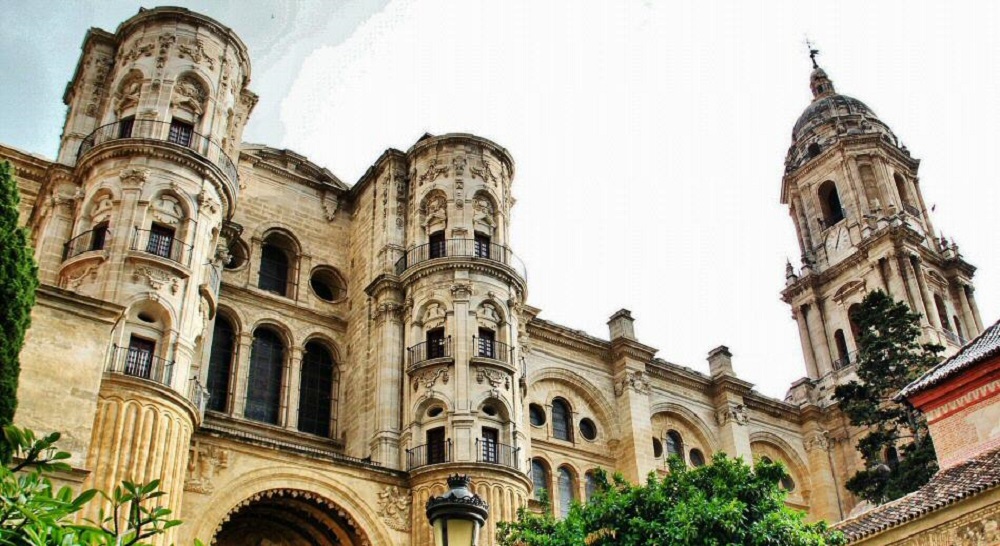
The Halt of Construction
The construction of the cathedral came to a halt in the late 18th century. The lack of funds, coupled with the political instability of the period, made it impossible to complete the project. The cathedral was left with just one tower, earning it the affectionate nickname “La Manquita”. Despite its unfinished state, the cathedral stands as a testament to the city’s resilience and the enduring spirit of its people. It is a symbol of Málaga’s rich history and cultural heritage, a beacon of hope in the face of adversity.
The story of La Manquita is a story of resilience, of a city and its people who, despite the challenges, managed to create a masterpiece. The cathedral, with its single tower, stands as a symbol of Málaga’s rich history and cultural heritage. It is a testament to the city’s past, a beacon in its present, and a promise for its future. As we delve deeper into the history of La Manquita, we discover not just the story of a building, but the story of a city and its people. It is a story of faith, resilience, and enduring beauty, a story that continues to unfold with each passing day.
La Manquita in Modern Times
The Visit of the Queen
As we move forward in time, we arrive at a significant moment in the cathedral’s history – the visit of Queen Isabel II in 1862. This royal visit brought a renewed sense of importance and prestige to the cathedral. The city of Málaga, decked out in its finest, welcomed the queen with great fanfare. The cathedral, despite its unfinished state, was the centerpiece of the royal visit. The queen’s visit was a testament to the cathedral’s significance, not just as a religious institution, but also as a symbol of Málaga’s cultural and historical heritage.
From the 20th Century to the Present
As we move into the 20th century and beyond, the cathedral continues to hold a special place in the hearts of the people of Málaga. Despite numerous proposals and plans to complete the second tower, the cathedral remains “La Manquita”, the one-armed lady. This unfinished state, far from being a source of embarrassment, has become a source of pride for the locals. It is a testament to the city’s resilience and its ability to find beauty in imperfection.
In the present day, the cathedral stands as a symbol of Málaga’s rich history and vibrant culture. It is a popular tourist destination, attracting visitors from around the world with its unique blend of Gothic and Renaissance architecture, its stunning choir, and its fascinating history. The cathedral also continues to serve as a place of worship, hosting regular services and special events.
Despite the passage of time, the cathedral remains a constant in the ever-changing cityscape of Málaga. It is a reminder of the city’s past, a beacon in its present, and a promise for its future. As we look at the cathedral, with its single tower reaching for the sky, we are reminded of the enduring spirit of Málaga, a city that has faced challenges with resilience and grace, and has emerged stronger with each passing century.
The story of La Manquita is not just the story of a building, but the story of a city and its people. It is a story of faith, resilience, and enduring beauty, a story that continues to unfold with each passing day. As we stand in the shadow of the cathedral, we are reminded of the enduring spirit of Málaga, a spirit that is reflected in the stones of La Manquita, the heart of Málaga.
The Architectural Marvel of La Manquita
The Unique Blend of Styles
One of the most fascinating aspects of La Manquita is its unique blend of architectural styles. The cathedral is a harmonious fusion of Gothic and Renaissance elements, a testament to the changing tastes and preferences of the period. The initial Gothic design, with its pointed arches and intricate details, was replaced by the more modern and innovative Renaissance style. This shift in architectural style is evident in the cathedral’s design, from the grand central nave to the intricate carvings that adorn the interior.
Also read our blog about: The Influence of Moorish Architecture in Andalusian Cities
The Single Tower
Perhaps the most distinctive feature of La Manquita is its single tower. Originally, the design called for two towers, but due to a lack of funds, only one was completed. This single tower, reaching a height of 84 meters, is a striking feature of the cathedral’s facade. Despite its unfinished state, the tower is a masterpiece of Renaissance design, a testament to the architectural brilliance of the era.
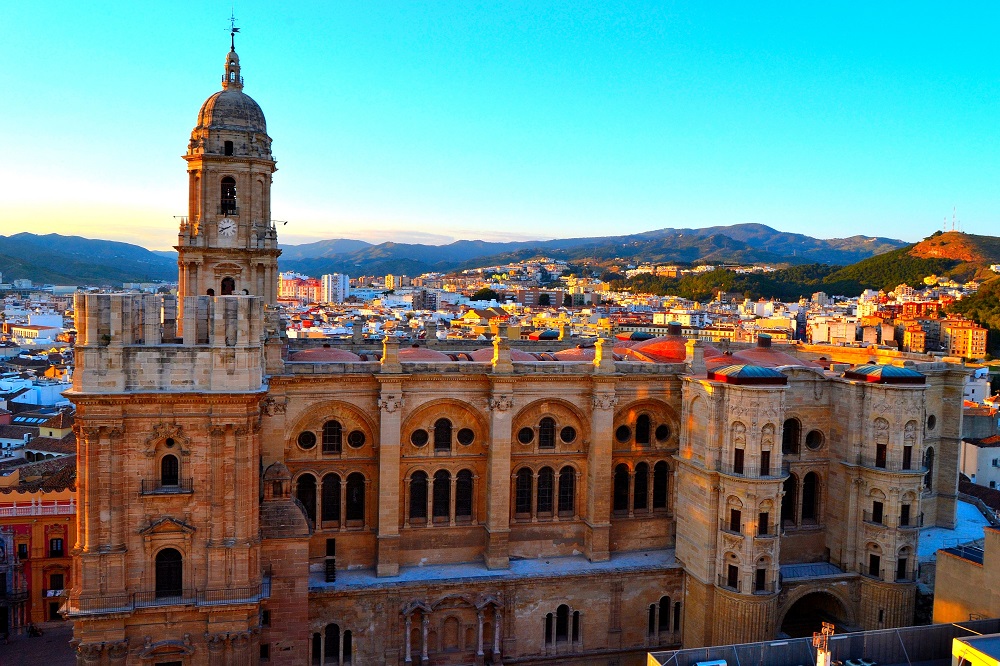
Visiting La Manquita: A Practical Guide
Location and How to Get There
La Manquita is located in the heart of Málaga, at Calle Molina Lario, 9. It is easily accessible on foot from anywhere in the city center or by public transport, which will leave you nearby.
Opening Hours
The cathedral has different opening hours depending on the time of year. From November 1 to March 31, it is open from Monday to Friday from 10:00 a.m. to 9:00 p.m., on Saturdays from 10:00 a.m. to 6:00 p.m., and on Sundays from 2:00 p.m. to 6:00 p.m. From April 1 to June 30 and October 1 to October 31, it is open from Monday to Friday from 10:00 a.m. to 8:00 p.m., on Saturdays from 10:00 a.m. to 6:00 p.m., and on Sundays from 2:00 p.m. to 6:00 p.m. From July 1 to September 30, it is open from Monday to Friday from 10:00 a.m. to 9:00 p.m., on Saturdays from 10:00 a.m. to 6:00 p.m., and on Sundays from 2:00 p.m. to 6:00 p.m.
Tickets and Prices
Tickets to the cathedral can be obtained both in person, at the box office, or online. The box office is located at the door in the Patio de los Naranjos. The prices vary depending on age and type of visit. The general ticket price is €6, while the price for seniors (over 65 years old) is €5.50. Groups of more than 15 people can get tickets for €4 per person. Youth tickets (for ages 13 to 17) are €3, and student tickets (for ages 18 to 25) are €4. Schoolchildren under 12 years in group can get tickets for €2. Entrance to the cathedral is free for residents of Málaga, people with disabilities, and children under 13 years of age.
Visiting the Roofs of the Cathedral
In addition to the classic visit to the interior of the cathedral, you can also visit the roofs of the cathedral, which has its own schedule and prices. The prices for access to the roof of the cathedral are €6 for general tickets, €5.50 for seniors, €4 for groups, €3 for youth, and €4 for students. Schoolchildren under 12 years in group can get tickets for €2.
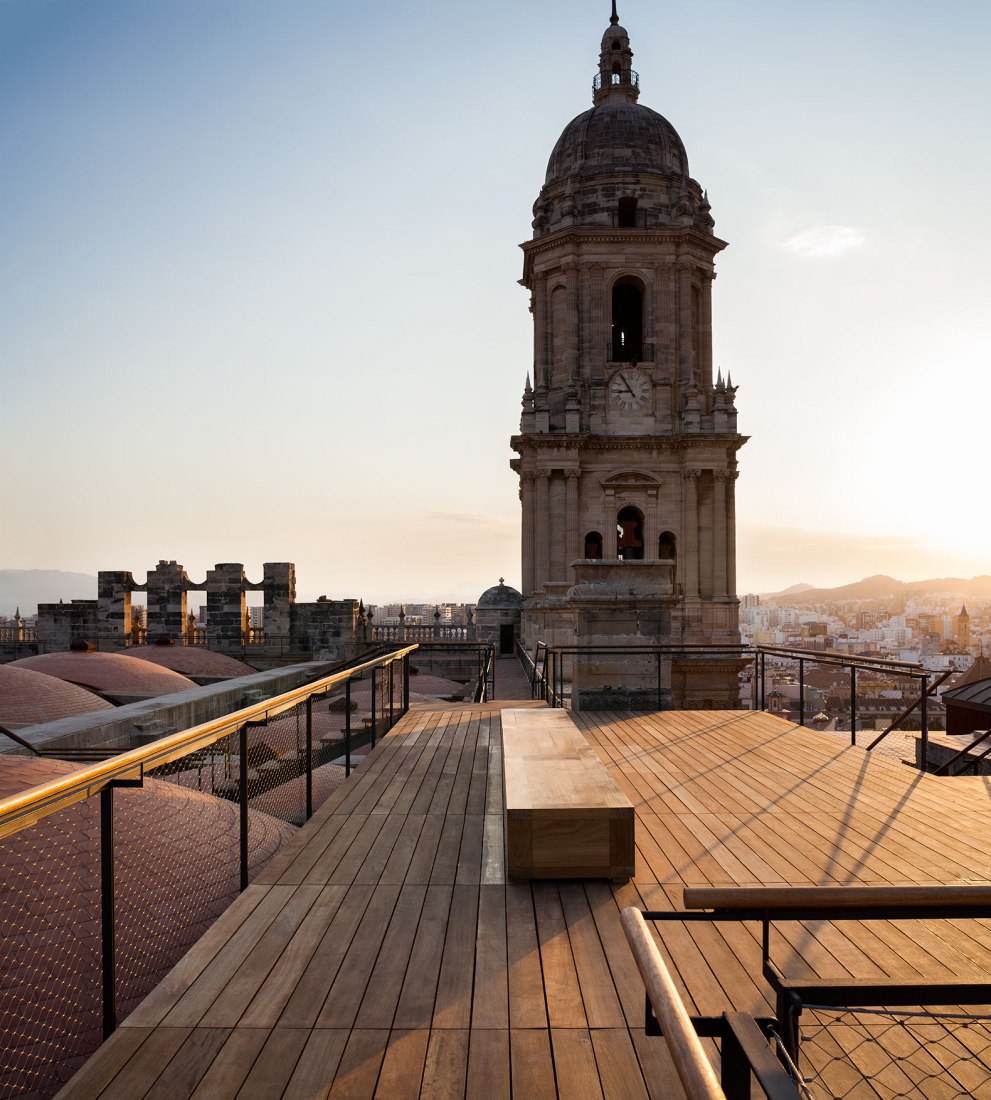
Booking in Advance
Given the popularity of La Manquita, it is advisable to book your tickets in advance, especially during the peak tourist season. This can be done online through the official website of the cathedral.
Free Entrance
Free admission to the Cathedral of Malaga is from 9 to 10 in the morning from Monday to Thursday for the general public. This free ticket does not include an audio guide and is valid only for the cathedral.
For more detailed information, you can visit the official website of the cathedral: https://malagacatedral.com
Best Rooftops to View La Manquita
One of the most captivating ways to appreciate the grandeur of La Manquita is from a distance, especially from the vantage point of a rooftop. Here are some of the best rooftops in Malaga where you can enjoy a panoramic view of the cathedral while sipping on a cocktail or enjoying a meal.
AC Hotel Malaga Palacio
Located on the 15th floor, the rooftop bar at the AC Hotel Malaga Palacio offers an incredible view over the city, harbor, and the Mediterranean Sea. It’s one of the best views in the city. The rooftop is open all day long, allowing you to enjoy lunch, cocktails, fine dinner, or aperitifs with a stunning backdrop of La Manquita.
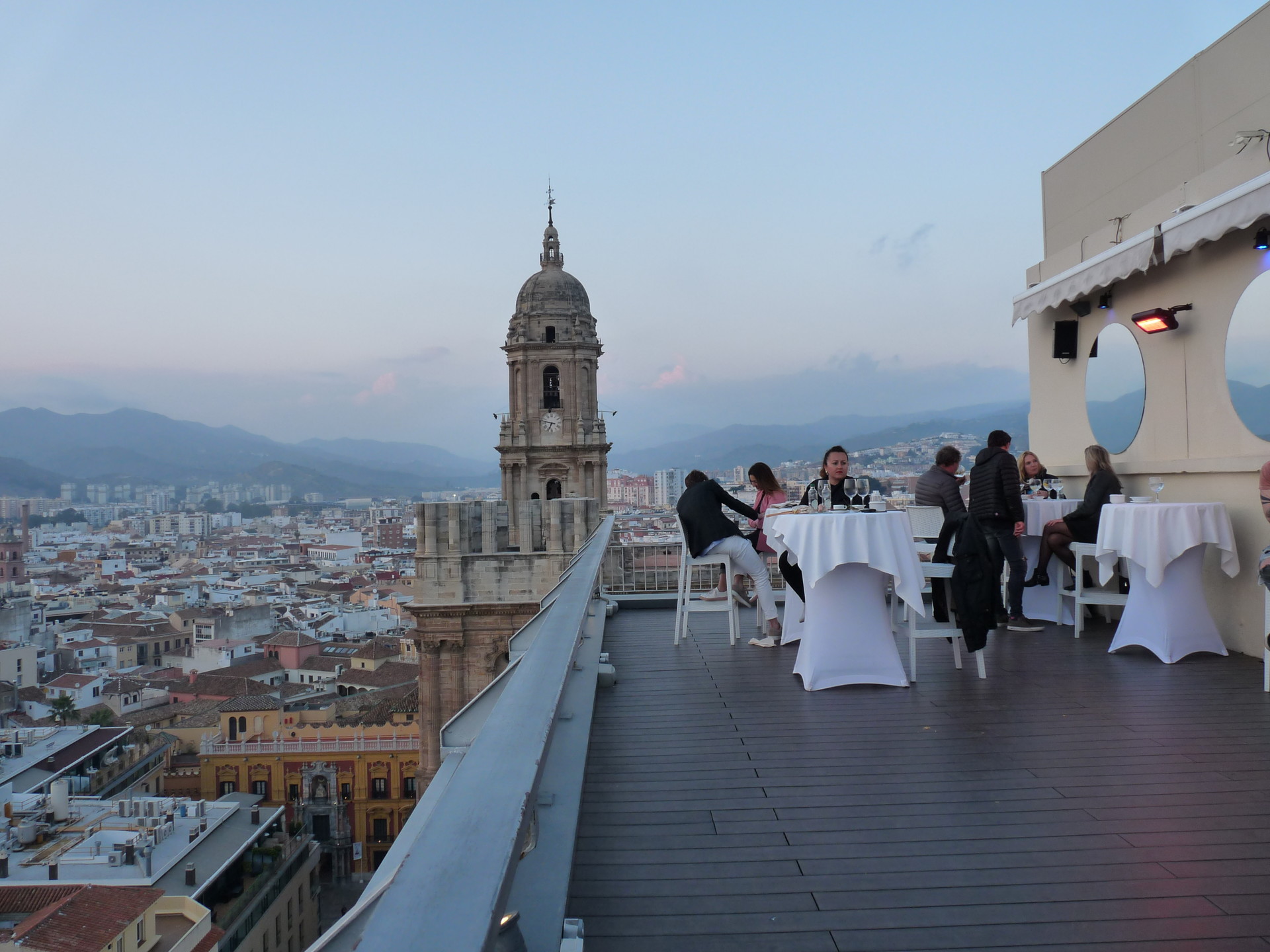
La Terraza Oasis
Situated on top of Oasis Backpackers’ Hostel, La Terraza Oasis is a classic and relaxed rooftop bar known for its good prices on drinks and a live DJ keeping the vibe high. The rooftop bar serves a wide range of different and well-crafted cocktails, especially Gin & Tonics, which they are famous for.

Room Mate Larios Hotel
Larios Terrace, on top of the Room Mate Larios Hotel, is located at the busy and famous Marchues de Larios Street. The rooftop offers panoramic views over the cathedral and the city rooftops. Enjoy classic and well-made cocktails from the rooftop bar and live DJs, various parties, and fashion shows when summer evening turns to night.

The Top at Hotel Molina Lario
Located at the Hotel Molina Lario, The Top offers two terraces on the 6th and 8th floors, combining panoramic views over the mountains, the Cathedral, and the Mediterranean. It’s an ideal place for both after work, refreshing cocktails in the all day sun, tapas, or more late-night party. The rooftop bar is famous for its creative and delicious cocktails.

As we conclude our journey through the history and architectural grandeur of La Manquita, it becomes clear why this iconic cathedral holds such a special place in the hearts of Malagueños. Despite its unfinished state, or perhaps because of it, La Manquita stands as a symbol of Málaga’s resilience, its rich history, and its vibrant culture. It is a testament to the city’s past, a beacon in its present, and a promise for its future. As you walk away from its towering presence, you carry with you a piece of Málaga’s soul, etched in the stones of La Manquita. So, the next time you find yourself in Málaga, make sure to pay a visit to this one-armed lady, and let her tell you her story, a story of faith, resilience, and enduring beauty.




